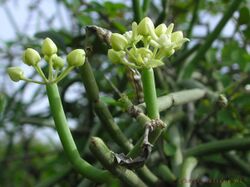Biology:Sarcostemma acidum
| Sarcostemma acidum | |
|---|---|

| |
| Sarcostemma acidum | |
| Scientific classification | |
| Kingdom: | Plantae
|
| (unranked): | |
| (unranked): | |
| (unranked): | |
| Order: | |
| Family: | |
| Subfamily: | |
| Tribe: | |
| Subtribe: | Cynanchinae
|
| Genus: | |
| Species: | S. acidum
|
| Binomial name | |
| Sarcostemma acidum (William Roxburgh) (Joachim Otto Voigt)
| |
| Synonyms | |
| |
Sarcostemma acidum[1] (a name established in 1845 by Joachim Otto Voigt), is a species of flowering plant in the family Apocynaceae and is typically found in the valleys and sub tropical mountains in the Himalayas. The plant is religiously linked to Hinduism and is believed to be a major ingredient of the Soma in Ancient India.[2]
Description
Sarcostemma acidum is a perennial leafless, jointed shrub with green, cylindrical, fleshy glabrous with twining branches having milky white latex and with its leaves reduced to scales. Its flowers are white or pale greenish white, are fragrant and grow in umbels on branch extremities. The fruits follicles taper at both ends, seeds are flat, ovate. comose. The plant is bitter, acrid, cooling, alterant, narcotic, emetic, antiviral and rejuvenating. It is useful in vitiated conditions of pitta, dipsia, viral infection, hydrophobia, psychopathy and general debility.[3]
This leafless plant grows in rocky, sterile places all over India . The plant yields an abundance of a mildly acidulous milky juice, and travellers like nomadic cowherds suck its tender shoots to allay thirst. Traditional accounts hold that Sarcostemma acidum is the Soma or Som plant of the Vedas. The Rig Veda, ix. says, the purifying Soma, like the sea rolling its waves, has poured forth songs, hymns and thoughts.[4]
References
- ↑ Quattrocchi, Umberto (2016). CRC World Dictionary of Medicinal and Poisonous Plants. CRC Press. p. 3328. https://books.google.com/books?id=-37OBQAAQBAJ&pg=PA3328&dq=sarcostemma+acidum&hl=en&sa=X&ved=0ahUKEwj7wbnhjsXWAhVMOY8KHWslBJQQ6AEIIzAA#v=onepage&q=sarcostemma%20acidum&f=false.
- ↑ Singh, N. P. (1988). Flora of Eastern Karnataka, Volume 1. Mittal Publications. p. 416. https://books.google.com/books?id=6-g-nU3bTjcC&pg=PA416&dq=soma&hl=en&sa=X&ved=0ahUKEwj7wbnhjsXWAhVMOY8KHWslBJQQ6AEITjAH#v=onepage&q=Soma&f=false.
- ↑ Warrier, P. K.; Nambiar, V. P. K. (1993). Indian Medicinal Plants: A Compendium of 500 Species, Volume 5. Orient Blackswan. p. 73. https://books.google.com/books?id=y3_vZIUVVj8C&pg=PA73&dq=sarcostemma+acidum&hl=en&sa=X&ved=0ahUKEwjPsNeelsXWAhWLtI8KHZ4TAbIQ6AEILDAC#v=onepage&q=sarcostemma%20acidum&f=false.
- ↑ Balfour, Edward (1885). The Cyclopædia of India and of Eastern and Southern Asia: Commercial, Industrial and Scientific, Products of the Mineral, Vegetable, and Animal Kingdoms, Useful Arts and Manufactures, Volume 3. Bernard Quaritch. p. 535. https://books.google.com/books?id=iU0OAAAAQAAJ&pg=PA535&dq=sarcostemma+acidum&hl=en&sa=X&ved=0ahUKEwii686Lk8XWAhUGqo8KHXDlCKQQ6AEIIzAA#v=onepage&q=sarcostemma%20acidum&f=false.
External links
Wikidata ☰ Q3950495 entry

